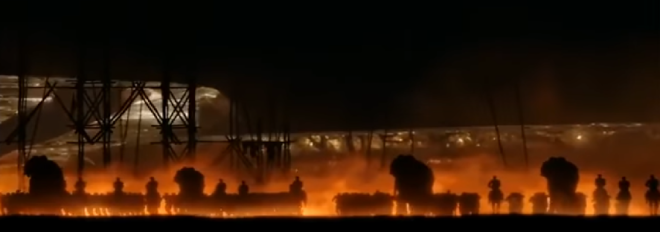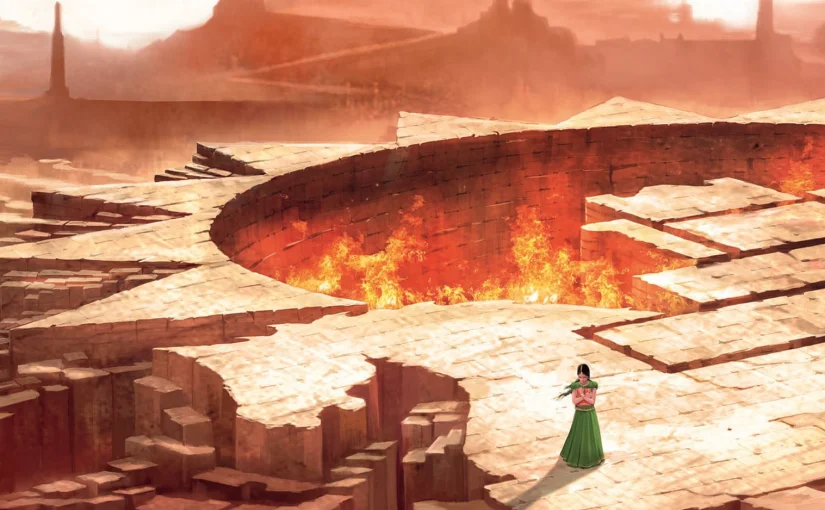Disclaimer: I am a self declared citizen of Mahishmati Kingdom, which translates to being obsessed with anything connected to Mahishmati Samrajyam. I sometimes find myself day-dreaming about ghost-walking the long corridors of Mahishmati Durbars. I can’t possibly look at this book as a standalone creative work but can only perceive it as a part of a larger creative whole.
Firstly, did the book stand up to the quality of the movies? It certainly did live up to the expectations and achieved its purpose of expanding the Baahubali universe in a very organic manner. However I dare criticize some aspects of the book in the post.

One of the most artistic sequence in Baahubali – The Beginning occurs even before the titles roll. The short scene depicts thousands of foot soldiers, workers(not slaves I hope), Dandanayakas and Senathipathis on horses and elephants working together to lift up the “structure” of Baahubali up. This is Rajamouli’s symbolic way of paying tribute to all those who have toiled for the film. In a humble manner he doesn’t depict a Chief who leads the efforts, but shows tens of Dandanayakas who collectively allude to Rajamouli himself, MM Keeravani, Senthil, Shobu, Sabu Cyril, V. Srinivas and the actors. After this book, Anand certainly deserves a place in that pack as he, through his book, single handedly nourished the banyan sapling planted by the movies in to a gaint tree.
Anand expands the universe to introduce about 40 new characters some of whom ended up being more interesting than even Kattappa and Sivagami! This is a great achievement considering that the book was written in a short span of just 108 days. I was afraid that the book will be piggybacking on the success of the film and end up being a mere appendix for the movie. However Anand puts his stamp on the book and goes in to many unchartered territories which the movie has not even hinted about. With this highly entertaining and quality content at hand, the producers can safely venture in to creating mini TV series based on the book. However it could be difficult for the producers to find the right Dandanayakas(Directors) that can justify the content of the book because of its gigantic scale and adult themes of gore and sex.
Baahubali the beginning limits itself to character introduction and offering visuals to the grand kingdom and the surrounding topography. The books fills in the gaps by discussing the economy, geography, politics and a brief history of the Kingdom. From the book we can infer that the location of the Kingdom is not set in India exactly. I like to think that it is set in a parallel universe which has many similar characteristics to the real world medieval India in its customs, food and geography. Consider these facts: the food the characters eat in the book is Tamil food (talk about Sambhar and Dosas), they speak Telugu(calling father as Naanna), the historic Mahishmati was located in present day Madhya Pradesh, the Maharani is from the colder regions of Himalayas and other various disoriented features of the Kingdom does not fit with the reality of India. George RR Martin of Game of Thrones, uses similar technique of placing his story in a place that is very similar to present day Europe in its customs, dressing, history and food but the maps of the ‘Seven Kingdoms’ created by Martin does not align with that of Europe.
The most surprising part about the book is the lack the elements that we expect from a Rajamouli movie. The most striking is the non-existence of an all powerful, nobel and handsome hero. Every character in the book has weaknesses. Kattappa is not a hero as he is brainwashed by his father in to thinking that slavery is divine dharma and that entertaining mere thoughts about ‘freedom’ is a sin. Shivagami is still a child, who shows lot of courage but is not mature enough to be called a ‘hero’. Shivappa is the character that most resembles a typical hero, the one who fights against the injustices of the elite, who is strong and also is the only one in the book who has a sweet romance. Shivappa actually reminded me of Prabhas’s role in another Rajamouli’s movie called Chatrapati, where the srilankan refugees are used as defacto slaves by the smuggling mafia and a Kattappa type character keeps Shivappa type character(Yong rebel star Prabhas) in reign till he unleashes his rebelism! But here Kattappa is the central character and Shivappa fails in his revolt. Another interesting thing is that, in the movie, the Kings of Mahishmati are shown as good people. Amarendra Baahubali, Mahendra Baahubali, King Mahadeva resemble each other. So you would expect Prince Mahadeva to be a heroic character like his son and grandson, but he turns out to a total whimp! Instead Prince Bijjala is a great warrior but a cruel one though.
I am glad that Arka Media and Rajamouli choose Anand, a Malayalee as the author of the book. This is because, I don’t think a Telugu writer would have dared to write a book without a central hero type character. There is a huge void of world class talent in art streams and other artistic pursuits like writting, music and film art in Telugu states. The result is that we are now burdened with at best mediocre talent which is good enough for a non-art educated crowd who can’t themselves differentiate between high and low art. On a side note, Rajamouli over the years has been reinventing himself many times and has gradually transitioned in to a better director. Another reason why Anand being a Malayalee is a good thing is that, he brought in a very critical political angle to the book by powerfully depicting the horrors of class system and untouchability. If only, slaves were given education, Shivappa could have been the Karl Marx of Mahishmati. I think that no artist from Kerala can ignore the literature of communist ideas and be disgusted by the utter injustice in the practice of untouchability. Interestingly not even one noble, except may be Prince Mahadeva for some extent, has been depicted as a good person and as being sympathetic to the Slaves. The only noble who is compassionate is Skandadasa but he belongs to the lowest of the low castes. Even Maharaja Somadeva and his Maharani were not shown in good light. I don’t know if this was done by design or if its because of the author’s subconscious mistrust of the elite. I also wonder if Rajamouli has thought about the book in this angle where the central plot is the fight between Marxists, environmtalists and the ultras against the establishment and the bureaucracy.
Another interesting aspect where the book deviates from the movie is the dearth of grey characters. Rajamouli breaking away from the tradition of masala cinema wanted his father & the story writer Mr Vijayendra Prasad to create grey characters for the movie. And they largely succeeded in that as some people I interacted with could sympathize with the motivations of Bhallaladeva. But in the book, Anand clearly establishes who are the good and bad guys and whom as readers we should root for. This was unexpected as Anand’s previous books were written from the point of view of Villains (I infer so, from the titles).
The Author had both advantages and disadvantages writing a prequel story to an already released movie. The huge probability for success of the book and that million of people have already connected to the central characters gives confidence and allows the author to take risks with the structure and content of the book. Another advantage is the comfort of utilizing the visual cues presented in the movie and not bother writing long passages describing that imaginary place. Well, Anand had certainly utilized the first advantage and has created a worthy book. However in the case of the second advantage, Anand took it too far, he did not even bother adequately describing the places that we learn about for the first time in the book. After I finished the book it felt like I have rapidly flipped through a huge collection of books and have been allowed to briefly peek in to twenty great stories without really allowing me to fully enjoy any one of them. Through the book I wanted to be transported in to the world of Mahishmati, where I could breathe in the cool air from the mountains and sip the warm waters of Mahishi river. Alas, after I finished the book, I did not get to experience that. Though it made me wanting for more, it felt incomplete.
Of course the big disadvantage is the presence of constrains put in by the movie. This limits the freedom of the author to take the story in which ever direction he wants, this is because the climax of the story has already been shown in the movies. What ever path Anand’s characters take, their stories must lead to the already established climax. Also the character conception of Anand some times did not quite fit in with the characters visualised by Vijayendra Prasad and Rajamouli. For example, in the movie, though Bijjala is shown as cruel, in many scenes he is also depicted as rather clownish. But in the book, there is no goofy side to him, he is a straight up narcissistic psycho and a sex maniac.
Another interesting thing that I liked about the book is that the magical aspects and mythology were just a small part of the story, instead the book focuses more on human drama and the choices that people make when faced with incredible situations. It felt like an adult version of ”Chandamama” story with GoT levels of gore and sex.
The only paranormal part of the story is the mysterious Gauridhooli which helps make weapons invincible. It is this secret factor that makes Mahishmati the most powerful kingdom. However in the movie, only one piece of weapon was given special focus- the ”Sword of Amarendra Baahubali”. And the weapons of Mahishmati shown in the movie do not seem to have any magical powers. Hence we can infer that the last surviving weapon made from Gauridhooli is this sword which is also shown as being worshiped by Kattappa in the movie. Another reason for this theory is that Rajamouli is currently making a Vitrual Reality feature titled ‘Sword of Baahubali’, so the sword is certainly special. Also, we can infer that Mahishmati Kigdom is not using Gauridhooli to make weapons anymore from the fact that Kattappa is shown as the in charge of ordance of the Kingdom where weapons are manufactured openly unlike the secret underground armoury described in the book.
I hoped that, as in the movies there would be at least one large battle sequence in the book. There was an attempted coup at the end but all the real drama and action takes place at the fringes of it. Now that the Vaitalikas are almost wiped out, I fear that we may not get to ‘see’ a huge battle sequence in the future books as well. I don’t have any hopes on the lady pirates of Nagamma or the little vassal kingdoms colluding with some pesky government officials to provide any formidable challenge to the suzerainty of the Mahishmati Kingdom.
The book as in the movie ends with a question. Instead of “why a character choose to kill someone he loved”, the books ends with the question “will a character chooses to kill someone she loves”. Now that’s the sort of cliffhanger that result in blockbusters, it was proven with the movie, let’s see if it gets repeated with the books.
